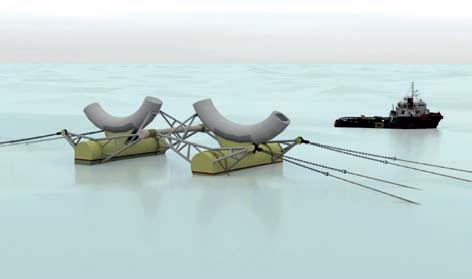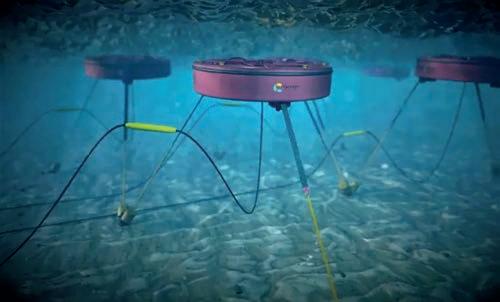
5 minute read
Advancing wave energy technologies
The frst EuropeWave Annual Conference was held online on 22 February and introduced the seven wave energy projects selected for the frst phase of the organisation’s pre-commercial procurement funding programme.
Following a strong response to the initial call for tenders, seven successful project teams have been selected by a panel of independent experts. They will share a budget of USD 2.6 million to further develop their wave energy device concepts in the frst half of 2022. The conference served as a showcase for the Phase 1 projects, selected following a strong response to the initial call for tenders. Project leaders shared their project concepts and discussed how to accelerate the commercialisation of the wave innovations.
Cost-efective
EuropeWave is an innovative R&D programme for wave energy technology, which runs from 2021 to 2025. It combines over USD 25 million of national, regional and EU funding to drive a competitive Pre-Commercial Procurement (PCP) programme for wave energy. The programme focuses on the design, development, and demonstration of cost-efective wave energy converter (WEC) systems for electrical power production that can survive in the harsh and unpredictable ocean environment. The EuropeWave PCP challenge is to advance promising wave energy converter systems to a point from which they can be developed to commercial exploitation through other national/ regional programmes and/or private sector investment. Match-funded by the EU’s Horizon 2020 programme, it is a collaboration between Wave Energy Scotland (WES), the Basque Energy Agency (EVE) and Ocean Energy Europe (OEE).
The seven successful projects
• Sea-Saw WEC (AMOG Consulting) The AMOG Sea-Saw technology is a dual hinged hull combined surge and pitch device with two power take of systems (PTOs). The hinge linked hulls with their independent PTOs and the resulting see-saw motion enable the device to access both the long period swell and shorter period wind driven waves, maximising the power production. The system is fully maintainable ofshore. The PTOs are easily accessible, thereby enabling PTO changeout by a single vessel whilst the WEC remains on its mooring.
• Trimaran (Arrecife Energy Systems) Arrecife Energy Systems Trimaran is based on a platform that causes the waves to break over it and extracts their energy by means of crossfow turbines located on the platform. This approach allows extracting both the potential and horizontal kinetic energy of the waves as opposed to other technologies only making use of the potential one, leading to capacity factors around 40%. The concept is a scalable, modular system that can extract energy from a varied set of wave conditions.
Image courtesy of AMOG Consulting.

• mWave (Bombora Wave Power Europe) Bombora’s mWave is a pneumatic WEC technology, based around a rubber membrane cell module. Multiple cell modules distributed on a submerged structure pump air to a turbine in a closed circuit. Bombora is building a full-scale pneumatic mWave demonstrator due for installation summer 2022. Larger output commercial systems will be built by simply increasing the number of cell modules – this is a relatively low risk step.
• Achieve (CETO Wave Energy Ireland) Achieve CETO is a fully submerged, point absorber type wave energy technology. A submerged buoy sits a few metres below the surface of the ocean and moves with the ocean’s waves. This orbital motion drives a PTO system that converts this motion into electricity. With three taught connections to the seabed, the Achieve CETO captures energy from all primary degrees of freedom. Advanced control optimises for every wave and can manage the WEC’s position and angle in the water column for both enhanced energy capture and survivability.

• Marmok Atlantic (IDOM Consulting,
Engineering, Architecture) IDOM’s wave energy harvesting technology is a point absorber based on the oscillating water column (OWC) working principle called MARMOK. The basic device concept can be described as a spar element holding a cylindrical water column inside. During operation, due to waves excitation, a relative movement between inner water column and buoy is produced. It makes water column act like a piston that comprises and expands the air chamber which is confned in the upper side of the buoy, generating a reciprocating air fow which is then converted into electric power using a power take of system composed by an air turbine. The absorbed power is transmitted to shore through a subsea cable.
Image courtesy of Bombora Wave Power Europe.


Image courtesy of Carnegie Clean Energy.

• Blue Horizon 250 (Mocean Energy) Mocean’s recognisable WEC architecture, a hinged raft with forward and aft wave channels, electric PTO and geometrically optimised using Mocean’s in-house expertise, is already established and proven via the WES NWEC program. Mocean’s new product line, Blue Horizon, is a medium to large scale hinged raft incorporating innovative features to maximise annual energy production, which built upon the success of the Blue X prototype.
• The Waveram (Waveram) The Waveram is a single-bodied, seaworthy, spar buoy. A surface-piercing foat supports a neutrally buoyant inertial mass of seawater and the ballast required for the design displacement. This combination of buoy, inertial mass and ballast is arranged to hold an internal column of seawater, open at the bottom and enclosed at the top within the foat. An air plenum between the two is connected to a high-pressure accumulator. As the spar buoy oscillates in heave it reacts, via the air plenum, against the internal column of water. This action pumps air into a high-pressure air accumulator, sufciently large to ensure a close-to-steady air fow through air turbines.

Image courtesy of Mocean Energy.
Photo courtesy of Waveram.

Accelerate scale-up
Following the completion of Phase 1, the fve most promising technologies will then be selected to progress to the second phase, where project teams will undertake more extensive design, modelling and testing to further develop their wave energy devices. The fnal phase of EuropeWave will then select the three most promising devices for testing in real sea conditions of the coasts of the Basque Country and Scotland in 2025. This pre-commercial procurement approach combines a competitive selection process with rigorous use of technical and economic performance indicators. It will accelerate wave energy’s scale-up and rapidly reduce costs, creating a path for wave energy to fulfl its potential as an integral part of Europe’s net-zero future.









